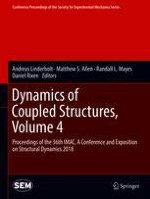2018 | Buch
Dynamics of Coupled Structures, Volume 4
Proceedings of the 36th IMAC, A Conference and Exposition on Structural Dynamics 2018
herausgegeben von: Dr. Andreas Linderholt, Matthew S. Allen, Prof. Dr. Randall L. Mayes, Prof. Daniel Rixen
Verlag: Springer International Publishing
Buchreihe : Conference Proceedings of the Society for Experimental Mechanics Series
